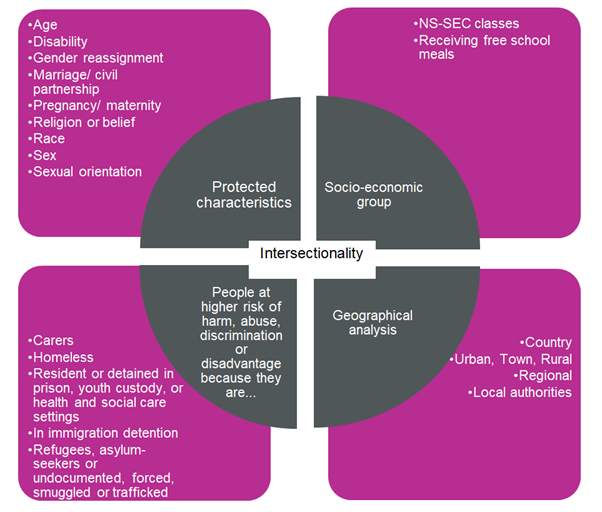 Karen Hurrell from the Equality and Human Rights Commission, and panellist for #DataImpact2021, explores how data help the Commission assess ‘Is Britain Fairer?’
Karen Hurrell from the Equality and Human Rights Commission, and panellist for #DataImpact2021, explores how data help the Commission assess ‘Is Britain Fairer?’
The Equality and Human Rights Commission (the Commission) is a public body established under the Equality Act 2006. As the national equality body covering England, Scotland and Wales and a national human rights institution recognised by the UN, our work is driven by a simple belief, that if everyone gets a fair chance in life, we all thrive.
And that work depends on the rich data landscape provided by British statistics.
A key part of our remit is to develop indicators on the progress of equality and human rights. This is a statutory requirement, and these indicators form the basis of our report to Parliament, which we must produce at least every five years.
In order to do this, we have developed a Measurement Framework. This identifies statistical measures and other evidence that enable us to monitor progress across six important areas of life. These are: education, work, living standards, health, justice and personal security, and participation.
The legislation also specifies nine characteristics which are protected and which need to be included in our reports on progress. These are: age, disability, gender reassignment, marital and civil partnership status, pregnancy and maternity, race, religion or belief, sex and sexual orientation. We also include socio-economic group (NS-SEC) in our analysis where possible.
Accessible version of this diagram.
The Measurement Framework identifies different types of evidence that we need to consider each time we report to Parliament, including the statistical measures. Overall, we specify over 50 statistical measures which provide an indication of what is happening in Britain. For each review, these must be populated with data disaggregated by as many as possible of the above characteristics. Many sources, both survey and administrative, provide this analysis, with the majority of survey microdata accessed through the UK Data Service.
Following the last review in 2018, we are currently gathering evidence for the next review. The pandemic has meant a change in schedule, with an interim publication ‘How coronavirus has affected equality and human rights’ published in October 2020. Further reports, including the statutory review, are expected to be published between now and late 2023.
The list below identifies the survey microdata obtained through the UK Data Service, and a summary of the topics and characteristics on which they provide data. As with everything these may change. At the time of writing the characteristics in square brackets appear in the relevant questionnaire, but are believed currently not to be available in the microdata.
Further information can be obtained from the data tables produced for the 2018 review, which provide details of sources and notes on the analysis. There is also a Technical Report available with further information.
Since the Commission’s first review in 2010, there have been many changes to the data landscape in Britain and more are anticipated. For example, new questions on sexual orientation and gender identity in the forthcoming censuses, and greater use of administrative data in future years.
I hope to see an even richer data landscape as a result of these developments.
Follow these links for further information
- The Commission’s Measurement Framework
- Reports in the ‘Is Britain Fairer?’ series
- Supporting data tables from 2018
- ‘How coronavirus has affected equality and human rights’
- UK Data ‘Service case study: What do the data tell us about ‘Is Britain Fairer’?
Sources used in ‘Is Britain Fairer?’ and accessed via the UK Data Service
- Annual Population Survey (Office for National Statistics)
- Topics covered in the Education domain are: young people not in education, employment or training (NEET), higher education and lifelong learning; and in the Work domain are: employment, pay and occupational segregation.
- Data collected on the protected characteristics: age, disability (including impairment type), marital and civil partnership status, race (ethnic group), religion, sex and sexual orientation, socio-economic group.
- Family Resources Survey and Households Below Average Income (Department for Work and Pensions)
- Provides data on poverty in the Living Standards domain.
- Data collected on the protected characteristics: age, disability (including impairment type), marital and civil partnership status, race (ethnic group), religion, sex and sexual orientation, socio-economic group.
- English Housing Survey (Ministry of Housing, Communities and Local Government)
- Provides data on housing in the Living Standards domain.
- Data collected on the protected characteristics: age, disability (including impairment type), marital and civil partnership status, race (ethnic group) and sex, socio-economic group.
- Scottish Household Survey, including the Scottish House Condition Survey (Scottish Government)
- This survey provides Scottish data across several domains. Topics covered: housing in the Living Standards domain; sport and exercise and social and community cohesion in the Participation domain.
- Data collected on the protected characteristics: age, disability (including impairment type), marital and civil partnership status, race (ethnic group), religion, sex and sexual orientation, socio-economic group.
- National Survey for Wales, including the Active Adults Survey and the Welsh Health Survey (Welsh Government)
- This survey provides Welsh data across several domains. Topics covered: housing and social care in the Living Standards domain; good health and poor mental health in the Health domain; sport and exercise and social and community cohesion in the Participation domain.
- Data collected on the protected characteristics: age, disability (including impairment type), marital and civil partnership status, pregnancy, race (ethnic group), religion, sex and sexual orientation.
- Health Survey for England (NHS Digital)
- Provides data on good health and poor mental health in the Health domain.
- Data collected on the protected characteristics: age, disability (including impairment type), marital and civil partnership status, pregnancy, race (ethnic group), religion, sex, [sexual orientation], socio-economic group.
- Scottish Health Survey (Scottish Government)
- Provides data on good health and poor mental health in the Health domain and on social and community cohesion in the Participation domain.
- Data collected on the protected characteristics: age, disability (including impairment type), marital and civil partnership status, pregnancy, race (ethnic group), religion, sex, [sexual orientation] and socio-economic group.
- Crime Survey for England and Wales (Office for National Statistics)
- Provides data on hate crime, sexual and domestic abuse, opinion of criminal justice system and restorative justice in the Justice and Personal Security domain.
- Data collected on the protected characteristics: age, disability (including impairment type), marital and civil partnership status, race (ethnic group), religion, sex, sexual orientation and socio-economic group.
- Scottish Crime and Justice Survey (Scottish Government)
- Provides data on hate crime, sexual and domestic abuse, opinion of criminal justice system in the Justice and Personal Security domain.
- Data collected on the protected characteristics: age, disability, [marital and civil partnership status], race (ethnic group), religion, sex, [sexual orientation] and socio-economic group.
- Community Life Survey (Department for Digital, Culture, Media and Sport)
- Provides data on political activities and social and community cohesion for England in the Participation domain.
- Data collected on the protected characteristics: age, [disability], marital and civil partnership status, race (ethnic group), religion, sex, sexual orientation and socio-economic group.
- Scottish Social Attitudes Survey (ScotCen)
- Provides data on political activities for Scotland in the Participation domain.
- Data collected on the protected characteristics: age, disability, [marital and civil partnership status], race (ethnic group), religion, sex, [sexual orientation] and socio-economic group.
- Opinions and Lifestyle Survey Internet Access Module (Office for National Statistics)
- Provides data on internet use and online privacy in the Participation domain.
- Data collected on the protected characteristics: age, disability, marital and civil partnership status, race (ethnic group), sex and socio-economic group.
- Taking Part Survey (Department for Digital, Culture, Media and Sport)
- Provides data on sport and exercise for England in the Participation domain.
- Data collected on the protected characteristics: age, disability (including impairment type), marital and civil partnership status, [pregnancy], race (ethnic group), religion, sex, [sexual orientation] and socio-economic group.
About the author
Dr Karen Hurrell is a professional statistician who has worked for the Equality and Human Rights Commission since 2007, and previously for the Equal Opportunities Commission.
She has worked on a wide range of issues over the years, for example pay gaps, stop and search and hate crime statistics, and on all protected characteristics covered by the Equality Act 2010.
She is currently collating data for the next ‘Is Britain Fairer?’ statutory review.
Join us for #DataImpact2021: #IdentityInData – Who Counts? Visibility, voice and culture in data collection and use (24 February, 10.30-12.30), where Karen will be part of our panel.

